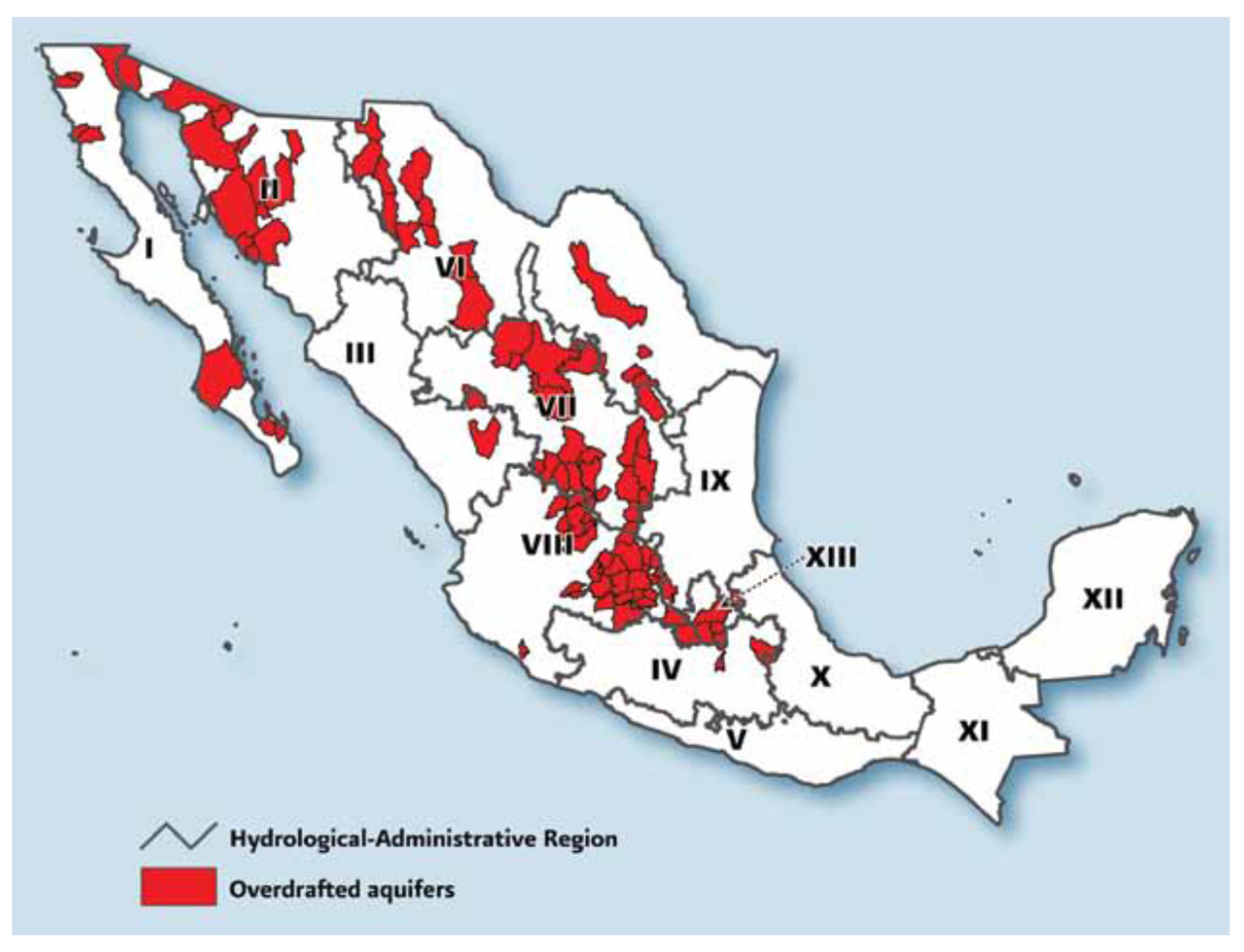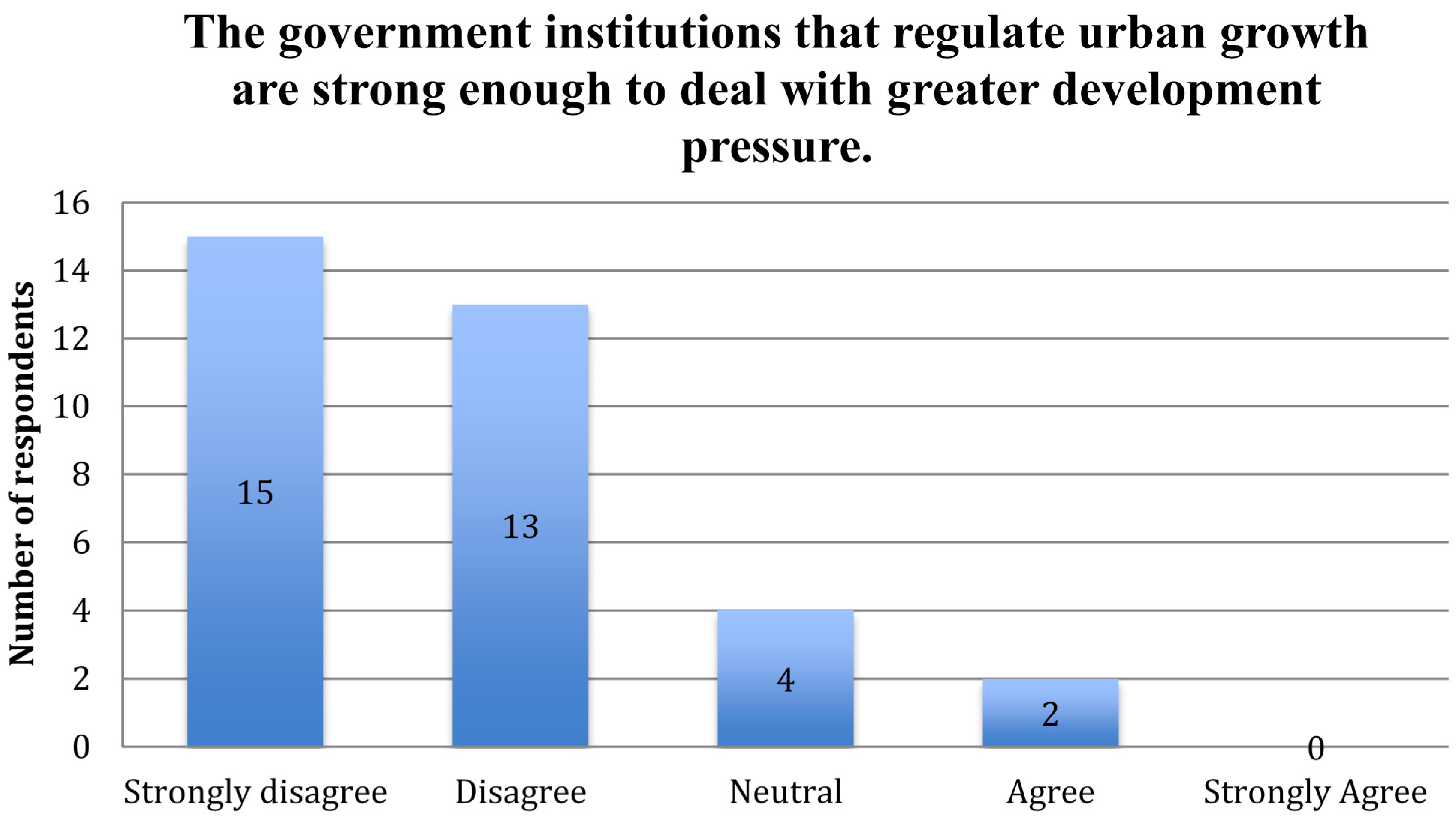Can the Adoption of Desalination Technology Lead to Aquifer Preservation? A Case Study of a Sociotechnical Water System in Baja California Sur, Mexico
Abstract
:1. Introduction
2. Literature Review
3. Methods and Case Study
3.1. Methods
| Affiliation | # of Interviewees |
|---|---|
| Federal government representatives | 9 |
| State government representatives | 4 |
| Local government representatives | 11 |
| Environmental Non-Governmental Organization (NGO) representatives | 5 |
| Academic/Researcher | 6 |
| Private sector representatives | 10 |
| Community residents | 23 |
| Other | 3 |
| Total # of Interviewees | 71 |
| Affiliation of Participants in Survey and Focus Group | # of Participants |
|---|---|
| Marine biologists | 7 |
| Students (marine biology, sustainable development, ecology, and unspecified) | 7 |
| Government employee (federal, state and local) | 5 |
| Professors (marine geology, agronomy, economy, unspecified) | 4 |
| Water-related NGO representatives | 2 |
| Other (geologist, economist, environmental consultant, system engineer) | 4 |
| No affiliation given | 7 |
| Total # of Participants | 36 |
3.2. Case Study

4. Results
4.1. Existing Institutional Arrangements for Managing Desalination Technology
4.2. Institutional Gaps for Ensuring Aquifer Preservation through Desalination Technology

5. Discussion and Conclusions
Acknowledgments
Author Contributions
Conflicts of Interest
References
- Richey, A.S.; Thomas, B.F.; Lo, M.; Reager, J.T.; Famiglietti, J.S.; Voss, K.; Swenson, S.; Rodell, M. Quantifying renewable groundwater stress with GRACE. Water Resour. Res. 2015, 51. [Google Scholar] [CrossRef]
- Cooley, H.; Gleick, P.; Wolff, G. Desalination, with a Grain of Salt: Perspectives from California; Pacific Institute: Oakland, CA, USA, 2006. [Google Scholar]
- Alcott, B. Jevons’ paradox. Ecol. Econ. 2005, 54, 9–21. [Google Scholar] [CrossRef]
- Hughes, T.P. Networks of Power: Electrification in Western Society, 1880–1930; Johns Hopkins University Press: Baltimore, MD, USA, 1983. [Google Scholar]
- Trist, E. The Evolution of Socio-Technical Systems as a Conceptual Framework and as an Action Research Program. In Perspectives on Organization Design and Behavior; van de Ven, A., Joyce, W.F., Eds.; John Wiley & Sons: New York, NY, USA, 1981; pp. 19–75. [Google Scholar]
- March, H. The politics, geography, and economics of desalination: A critical review. WIREs Water 2015, 2, 231–243. [Google Scholar] [CrossRef]
- National Research Council. Desalination: A National Perspective; The National Academies Press: Washington, DC, USA, 2008. [Google Scholar]
- McEvoy, J.; Wilder, M. Discourse and desalination: Potential impacts of proposed climate change adaptation interventions in the Arizona-Sonora border region. Glob. Environ. Chang. 2012, 22, 353–363. [Google Scholar] [CrossRef]
- Swyngedouw, E. Into the sea: Desalination as Hydro-Social Fix in Spain. Ann. Assoc. Am. Geogr. 2013, 103, 261–270. [Google Scholar] [CrossRef]
- Kallis, G. Political Ecology Gone Wrong. Available online: http://entitleblog.org/2015/05/07/political-ecology-gone-wrong/ (accessed on 25 September 2015).
- Robbins, P.; Moore, S.A. Love Your Symptoms: A Sympathetic Diagnosis of the Ecomodernist Manifesto. Available online: http://entitleblog.org/2015/06/19/love-your-symptoms-a-sympathetic-diagnosis-of-the-ecomodernist-manifesto/ (accessed on 25 September 2015).
- Lattemann, S.; Kennedy, M.D.; Amy, G. Seawater desalination—A green technology? J. Water Supply Res. Technol. 2010, 59, 134–151. [Google Scholar] [CrossRef]
- Sahin, O.; Stewart, R.A.; Helfer, F. Bridging the water supply–demand gap in Australia: Coupling water demand efficiency with rain-independent desalination supply. Water Resour. Manag. 2015, 29, 253–272. [Google Scholar] [CrossRef]
- Bates, B.; Kundzewicz, Z.W.; Wu, S.; Palutikof, J. Climate Change and Water; IPCC Technical Paper VI; IPCC: Geneva, Switzerland, 2008. [Google Scholar]
- March, H.; Saurí, D.; Rico-Amorós, A.M. The end of scarcity? Water desalination as the new cornucopia for Mediterranean Spain. J. Hydrol. 2014, 519, 2642–2651. [Google Scholar] [CrossRef]
- Instituto de Ingenería, Universidad Nacional Autónoma de México (IIUNAM). Situación Actual y Posibles Escenarios de Intrusión Salina en el Acuífero La Paz, BCS y su Aprovechamiento Como Fuente de Desalación Para Abastecimiento de Agua Potable; Instituto de Ingenería de la UNAM: Coyoacán, Mexico, 2010. (In Spanish) [Google Scholar]
- Bijker, W.E.; Hughes, T.P.; Pinch, T.J. The Social Construction of Technological Systems: New Directions in the Sociology and History of Technology; The MIT Press: Cambridge, MA, USA, 1987. [Google Scholar]
- Winner, L. Autonomous Technology: Technics-out-of-Control as a Theme in Political Thought; The MIT Press: Cambridge, MA, USA, 1977. [Google Scholar]
- Winner, L. Do Artifacts Have Politcs? Daedalus 1980, 109, 121–136. [Google Scholar]
- Jasanoff, S. The Fifth Branch: Science Advisers as Policymakers; Harvard University Press: Cambridge, MA, USA, 1990. [Google Scholar]
- Jasanoff, S. Designs on Nature: Science and Democracy in Europe and the United States; Princeton University Press: Princeton, NJ, USA, 2005. [Google Scholar]
- Birkenholtz, T. Irrigated landscapes, produced scarcity, and adaptive social institutions in Rajasthan, India. Ann. Assoc. Am. Geogr. 2009, 99, 118–137. [Google Scholar] [CrossRef]
- Megdal, S.B.; Dillon, P.; Seasholes, K. Water banks: Using managed aquifer recharge to meet water policy objectives. Water 2014, 6, 1500–1514. [Google Scholar] [CrossRef]
- Hirt, P.; Gustafson, A.; Larson, K.L. The mirage in the valley of the sun. Environ. Hist. 2008, 13, 482–514. [Google Scholar] [CrossRef]
- Berg, B.L. Qualitative Methods for the Social Sciences, 6th ed.; Pearson Education: Boston, MA, USA, 2007. [Google Scholar]
- Neuman, L.W. Social Research Methods: Qualitative and Quantitative Approaches, 6th ed.; Pearson Education: Boston, MA, USA, 2006. [Google Scholar]
- McEvoy, J. Desalination and water security: The promise and perils of a technological fix to the water crisis in Baja California Sur, Mexico. Water Altern. 2014, 7, 518–541. [Google Scholar]
- McEvoy, J. Desalination and Development: The Socioecological and Technological Transformation of the Gulf of California. Ph.D. Thesis, University of Arizona, Tuscon, AZ, USA, 15 July 2013. [Google Scholar]
- Wilder, M.; Scott, C.A.; Pineda Pablos, N.; Varady, R.G.; Garfin, G.M.; McEvoy, J. Adapting across boundaries: Climate change, social learning, and resilience in the U.S.-Mexico border region. Ann. Assoc. Am. Geogr. 2010, 100, 917–928. [Google Scholar] [CrossRef]
- Comisión Nacional del Agua (Conagua). Available online: http://www.conagua.gob.mx (accessed on 14 July 2015).
- National Water Commission of Mexico. Statistics on Water in Mexico, 2010 edition; National Water Commission of Mexico: Coyoacán, Mexico, 2010.
- Scott, C.A. The Water-Energy-Climate Nexus: Resources and Policy Outlook for Aquifers in Mexico. Water Resour. Res. 2011, 47. [Google Scholar] [CrossRef]
- Herrera-Toledo, C. National water master planning in Mexico. In National Water Master Plans for Developing Countries; Biswas, A.K., Herrera-Toledo, C., Garduño-Velasco, H., Tortajada-Quiroz, C., Eds.; Oxford University Press: Oxford, UK, 1997; pp. 6–53. [Google Scholar]
- Salmón, R. Binational water priorities for the Arizona–Sonora region. In Proceedings of the Arizona–Mexico Commission Water Committee Summer Plenary, Hermosillo, Mexico, 5 June 2009, (unpublished conference presentation).
- Comisión Nacional del Agua (Conagua). Strategic Projects for Drinking Water, Sewerage and Sanitation; Programa Nacional de Infraestructura: Coyoacan, Mexico, 2012. [Google Scholar]
- Pombo, A.; Breceda Solís, A.; Valdez Aragón, A. Desalinization and Wastewater Reuse as Technological Alternatives in an Arid, Tourism Booming Region of Mexico. Front. Norte 2008, 20, 191–216. [Google Scholar]
- Comisión Nacional del Agua (Conagua). Programa de Acciones y Proyectos para la Sustentabilidad Hídrica: Visión 2030, Baja California Sur; Conagua; Dirección Local Baja California Sur: La Paz, BCS, México, 2012. (In Spanish) [Google Scholar]
- Pineda Pablos, N. Requerimientos legales en México para la desalinización de aguas marinas. Agua y Saneamiento 2015, 60, 89–91. (In Spanish) [Google Scholar]
- Wilder, M.O.; Aguilar Barajas, I.; McEvoy, J.; Varady, R.G.; Megdal, S.; Pineda Pablos, N.; Scott, C.A. Desalination Technology in a Binational Context: Systemic Implications for Water, Society, Energy, and Environment in the Arizona-Sonora Portion of the U.S.-Mexico Border. In Proceedings of the Puentes Consortium Symposium on the Mexico-U.S. Border, Rice University, Houston, TX, USA, 26 April 2012.
- H. Congreso del Estado de Baja California Sur. “Decreta: Ley de aguas del Estado de Baja California Sur” dado en la sala de sesiones del poder legislativo; a los 14 días del mes de junio del año dos mil uno; Baja California Sur: La Paz, BCS, México, 2001. (In Spanish) [Google Scholar]
- H. Ayuntamiento de Los Cabos. Plan de Ordenamiento Ecológico del Municipio de Los Cabos (versión abreviada); H. Ayuntamiento de Los Cabos: Los Cabos, BCS, México, 1995. (In Spanish) [Google Scholar]
- Pineda Pablos, N.; Briseño Ramírez, H. ¿Por qué son mejores los organismos de agua de Baja California que los de Sonora? Instituciones locales y desempeño de los organismos públicos. Región y Sociedad 2012, 24, 181–212. (In Spanish) [Google Scholar]
- Carrillo Guer, Y. Diagnóstico de la Cuenca de La Paz; Protnatura Noroeste: La Paz, BCS, México, 2010. (In Spanish) [Google Scholar]
- Valdez Aragón, A.R. Diagnóstico, servicios ambientales y valoración económica del agua en el corredor turístico-urbano de Los Cabos, BCS. Ph.D. Thesis, Universidad Autónoma de Baja California Sur, La Paz, BCS, México, 2006. [Google Scholar]
- Bennett, V. Housewives, Urban Protest and Water Policy in Monterrey, Mexico. Int. J. Water Resour. D. 1998, 14, 481–497. [Google Scholar] [CrossRef]
- Loftus, A. Reification and the Dictatorship of the Water Meter. Antipode 2006, 38, 1023–1045. [Google Scholar] [CrossRef]
- Comisión Nacional del Agua (Conagua). Programa Nacional Hídrico 2007–2012. Available online: www.conagua.gob.mx/CONAGUA07/Contenido/Documentos/PNH_05-08.pdf (accessed on 15 August 2015). (In Spanish)
- H. XI Ayuntamiento de Los Cabos. Plan de desarrollo municipal 2011–2015; Ayuntamiento de Los Cabos: Los Cabos, BCS, México, 2011. (In Spanish) [Google Scholar]
- Bakker, K. Governance Failure and the World’s Urban Water Crisis; Cornell University Press: Ithaca, NY, USA, 2010. [Google Scholar]
© 2015 by the authors; licensee MDPI, Basel, Switzerland. This article is an open access article distributed under the terms and conditions of the Creative Commons Attribution license (http://creativecommons.org/licenses/by/4.0/).
Share and Cite
McEvoy, J. Can the Adoption of Desalination Technology Lead to Aquifer Preservation? A Case Study of a Sociotechnical Water System in Baja California Sur, Mexico. Water 2015, 7, 5224-5238. https://doi.org/10.3390/w7105224
McEvoy J. Can the Adoption of Desalination Technology Lead to Aquifer Preservation? A Case Study of a Sociotechnical Water System in Baja California Sur, Mexico. Water. 2015; 7(10):5224-5238. https://doi.org/10.3390/w7105224
Chicago/Turabian StyleMcEvoy, Jamie. 2015. "Can the Adoption of Desalination Technology Lead to Aquifer Preservation? A Case Study of a Sociotechnical Water System in Baja California Sur, Mexico" Water 7, no. 10: 5224-5238. https://doi.org/10.3390/w7105224





